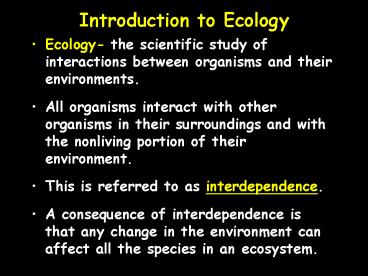Introduction to Ecology - PowerPoint PPT Presentation
1 / 12
Title:
Introduction to Ecology
Description:
Introduction to Ecology Ecology- the scientific study of interactions between organisms and their environments. All organisms interact with other organisms in their ... – PowerPoint PPT presentation
Number of Views:142
Avg rating:3.0/5.0
Title: Introduction to Ecology
1
Introduction to Ecology
- Ecology- the scientific study of interactions
between organisms and their environments. - All organisms interact with other organisms in
their surroundings and with the nonliving portion
of their environment. - This is referred to as interdependence.
- A consequence of interdependence is that any
change in the environment can affect all the
species in an ecosystem.
2
Effects of Interdependence
- Figure 18-1 .Page 360
- Connection between acorn production and Lyme
disease - more acorns ? more deer and mice ? more ticks ?
ticks carry bacteria that cause disease ? greater
chance of bitten by tick
3
What do you mean by environment?
- The environment is made up of two factors
- Biotic factors- all living organisms inhabiting
the Earth - Abiotic factors- nonliving parts of the
environment (i.e. temperature, soil, light,
moisture, air currents)
4
Abiotic and Biotic Factors
- Create a list of all the abiotic and biotic
factors that affect the survival of a fish
species in the aquarium.
5
- Levels of Organization
- Organism- any unicellular or multicellular form
exhibiting all of the characteristics of life, an
individual. - Lowest level of organization. (Most exclusive)
6
Population-a group of organisms of one species
living in the same place at the same time that
interbreed and compete with each other for
resources (ex. food, mates, shelter)
7
Community- several interacting populations that
inhabit a common environment and are
interdependent.
8
Ecosystem- a community and all the abiotic
factors found in a particular place (ex. marine,
terrestrial)
9
- Biosphere- life supporting portions of Earth
composed of air, land, fresh water, and salt
water. - Broadest, most inclusive level of organization.
- About 13 miles thick. (5-6 mi above surface to
deepest part of ocean)
10
Biosphere
Ecosystem
Community
Population
Organism
11
- Ecosystem Interactions
- Habitat- the place in which an organism lives out
its life (address) - Species do not use or occupy all parts of their
habitat. - The specific role, or way of life, of a species
within its environment is called its niche.
(job) - An organisms niche is how it meets its need for
food, shelter, and reproduction. - Plants and animals are able to share the same
habitats because they have different niches.
12
- A niche is determined by the tolerance
limitations of an organism, or a limiting factor.
- Limiting factor- any biotic or abiotic factor
that restricts the existence of organisms in a
specific environment. - Examples of limiting factors-
- Amount of water
- Amount of food
- Temperature































